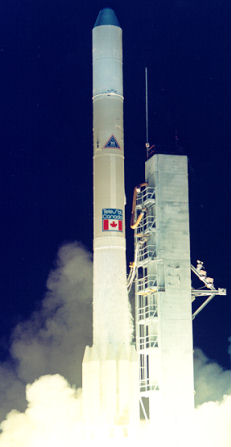DELTA 1000 SERIES FACT SHEET
By Cliff Lethbridge

Delta 1000 Series Launch, Photo Courtesy NASA
Classification: Space Launch Vehicle
Length: 106 feet, 4 inches
Diameter: 8 feet
Date of First Cape Canaveral Launch: September 22, 1972
Date of Final Cape Canaveral Launch: June 21, 1975
Number of Cape Canaveral Launches: 6
In order to describe the Delta 1000 Series rockets, it is first necessary to provide a description of an interim version of the Delta introduced as the Delta 900 Series. Delta 900 Series rockets were never launched from Cape Canaveral, but the vehicle did introduce enhancements which proved to be significant in Delta rocket evolution. A description of the Delta 1000 Series rockets, which were launched from Cape Canaveral, follows the description of the Delta 900 Series.
DELTA 900 SERIES
Classification: Space Launch Vehicle
Length: 106 feet, 4 inches
Diameter: 8 feet
Although Delta 900 Series rockets were never launched from Cape Canaveral, the introduction of the vehicle marked an important step in the evolution of the Delta program, and a vital link to the Delta rockets which followed. The Delta 900 Series launch vehicle added three Castor II solid rocket boosters to a cluster of six already employed for a total of nine. The rocket also introduced improved guidance and electronics. The second stage featured an improved Aerojet-General engine which burned Aerozine 50/nitrogen tetroxide liquid fuel, providing a thrust of 9,800 pounds. Six of the nine solid rocket boosters were ignited at liftoff. These burned out and were jettisoned as the remaining three were ignited and burned for an additional 39 seconds. The nine solid rocket boosters contributed a total of 480,600 pounds of thrust to the overall vehicle. The two-stage Delta 900 Series rocket, designated Delta 900, could carry a 3,700-pound payload to low-Earth orbit. The three-stage version, designated Delta 904, could carry a 1,400-pound payload to geostationary transfer orbit.
DELTA 1000 SERIES
Looking quite similar to the modern Delta launch vehicle, the Delta 1000 Series introduced an extended long tank configuration which has come to be known as “straight-eight”. While previous Delta rockets were tapered at the top, the Delta 1000 Series vehicles extended the 8-foot first stage diameter all the way to the top, with the exception of the rounded conical tip of the payload fairing. Since the upper stage diameters were now the same as the first stage, additional room was available at the top of the rocket to handle larger payloads. This upward extension of the first stage wall also provided added structural support for heavier payloads. Otherwise identical to the Delta 900 Series vehicle, the Delta 1000 Series offered an optional solid-propellant third stage which could produce a thrust of 15,400 pounds. This additional modification allowed the three-stage version of the Delta 1000 Series rocket to carry a 1,500-pound payload to geostationary transfer orbit. The “straight-eight” structural modification alone allowed the two-stage version of the Delta 1000 Series rocket to carry a 4,000-pound payload to low-Earth orbit.


